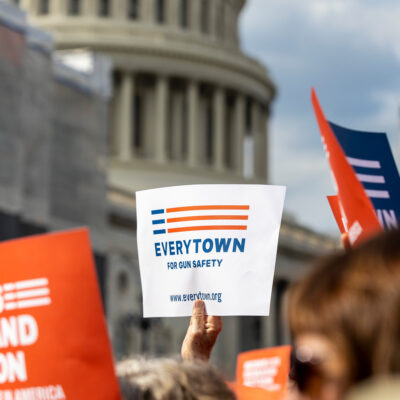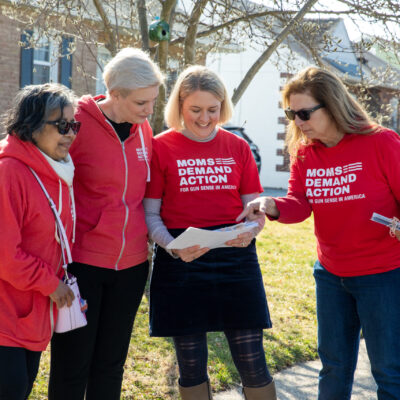Everytown For Gun Safety Urges ATF To Correct Regulatory Failure Allowing Untraceable ‘Ghost Guns’ Into Communities Across The Country
12.12.2019
Ghost Guns Are Unserialized, Untraceable Guns Often Made from Building Blocks That Can Be Purchased with No Background Check
ATF’s Current Failure to Regulate These Building Blocks Has Led to a Rise in Illegal Ghost Gun Production and Trafficking
The 16 Year-Old Shooter Who Killed Two and Injured Three in November School Shooting at Saugus High School Used a Ghost Gun
NEW YORK — Today, Everytown for Gun Safety demanded the Bureau of Alcohol, Tobacco, Firearms and Explosives (ATF) correct its own failure to regulate untraceable ghost guns. The demand comes in the form of a petition for rulemaking. The ATF does not currently classify unfinished frames and receivers — the core building blocks for ghost guns — as firearms, a position that allows a prohibited person or gun trafficker to buy all of the parts needed to easily build a ghost gun without a background check. Everytown’s petition urges the ATF to clarify that unfinished frames and receivers are firearms and, therefore, subject to background checks and other gun laws.
“Whether it’s made from a kit with minimal assembly or purchased fully assembled, a gun causes the same devastation in the wrong hands — and ghost guns can be easily purchased by gun traffickers, minors and people who are legally prohibited with no questions asked,” said Eric Tirschwell, managing director of litigation and national enforcement at Everytown Law. “With this petition, we’re not just saying that ATF is uniquely positioned to keep ghost guns out of the wrong hands — we’re saying it can immediately start the process to correct course and has the authority to do so on its own. It should be easy to order and assemble an IKEA bookshelf — not an untraceable firearm.”
Unfinished frames and receivers are the core building blocks for untraceable ghost guns. Though these unfinished frames and receivers are created with the express and singular purpose of being quickly converted into fully-functioning firearms, they are not currently classified as firearms by the ATF, and therefore can be purchased online — or from any other seller — without a background check. The ATF also does not require unfinished frames and receivers to have serial numbers, so the ghost guns created with these building blocks cannot be traced. The current lack of regulation and enforcement enables gun traffickers and people who are prohibited from owning firearms, like minors, convicted domestic abusers and those with violent criminal histories, to acquire all the parts necessary to build an untraceable firearm with no background check.
In the petition for rulemaking, Everytown Law provides detailed evidence and legal analysis on the following points:
- The ATF’s refusal to regulate unfinished frames and receivers as firearms has led to a flourishing ghost guns market that funnels untraceable firearms to gun traffickers and prohibited persons.
- Federal law requires regulating an unfinished frame or receiver as a firearm if it is “designed” to fire, or can “readily be converted” to fire.
- The ATF’s determination letters sent to businesses are inconsistent, erroneous and arbitrarily and capriciously narrow.
- The ATF’s recent regulation of bump stocks shows it is not bound by prior flawed private letter rulings.
Though the ATF does not currently classify unfinished frames and receivers as firearms, that wasn’t always the agency’s position. In a series of earlier determination letters issued between the 1980s and early 2000s, the ATF correctly explained to sellers of unfinished receivers that – so long as the receiver could be converted into a functioning firearm with relative ease – such receivers were “firearms” and subject to federal regulation.
But in the mid-2000s, the ATF reversed course. Without offering any explanation for changing its position, the ATF issued a series of poorly reasoned determination letters that effectively gave the green light for unlicensed online retailers to sell unfinished frames or receivers without background checks — even though those frames or receivers are designed, intended, and marketed to be readily converted into fully operable firearms.
There is now a thriving market for unfinished frames and receivers that are not serialized and do not require a background check to acquire. These unfinished frames and receivers are typically 80 percent complete and require the purchaser to use basic, widely accessible tools to complete the final 20 percent of work. For example, an online seller offers an unfinished pistol frame as part of a complete build kit, marketed with pictures of completed handguns conspicuously showing the lack of a serial number. The seller advertises a tool for finishing construction of an unfinished receiver and claims it is “ridiculously easy for a non-machinist to finish their 80 percent lower [receiver] in under 1 hour with no drill press required.” Sellers often provide links to milling instructions, instructional videos, and detailed diagrams of the different parts.
The ATF’s failure to regulate unfinished frames and receivers has endangered public safety. Over the last several years, law enforcement agencies have recovered ghost guns at an increasing rate. According to a recent report, the ATF estimates that 30 percent of guns recovered in California in connection with crimes have no serial number and are therefore untraceable. State and local law enforcement have reported recovering ghost guns from felons, criminal gangs, drug dealers, and minors. Ghost guns have also been used in high profile crimes, including:
- the recent school shooting at the Santa Clarita, California high school,
- the recent mass shooting in Midland and Odessa, Texas,
- a mass shooting with an AR-15 ghost gun that left five dead on a college campus,
- the shooting of four coworkers with a pistol made from parts purchased online by a person prohibited from purchasing a firearm, and
- a bank robbery and shootout with police involving assault rifle ghost guns.
Everytown calls on the ATF to amend the definition of “Firearm frame or receiver” in 27 C.F.R. § 478.11 as follows, with added text underlined and deleted language struck-through:
Firearm frame or receiver. That part of a firearm which provides housing for the hammer, bolt or breechblock, and firing mechanism, and which is usually threaded at its forward portion to receive the barrel trigger group, including any such part (1) that is designed, intended, or marketed to be used in an assembled, operable firearm, or (2) that, without the expenditure of substantial time and effort, can be converted for use in an assembled, operable firearm.
Read the full petition for rulemaking here.
Under the National Defense Authorization Act conference bill passed by the U.S. House this week and awaiting Senate action, the Department of Homeland Security (in coordination with the FBI) would be required to report on terrorists’ ability to acquire ghost guns. The provision, sponsored by Rep. Max Rose (NY-11), would require a report assessing the availability of conventional weapons — including unserialized, untraceable ghost guns — and advanced conventional weapons for use in furthering acts of terrorism.




